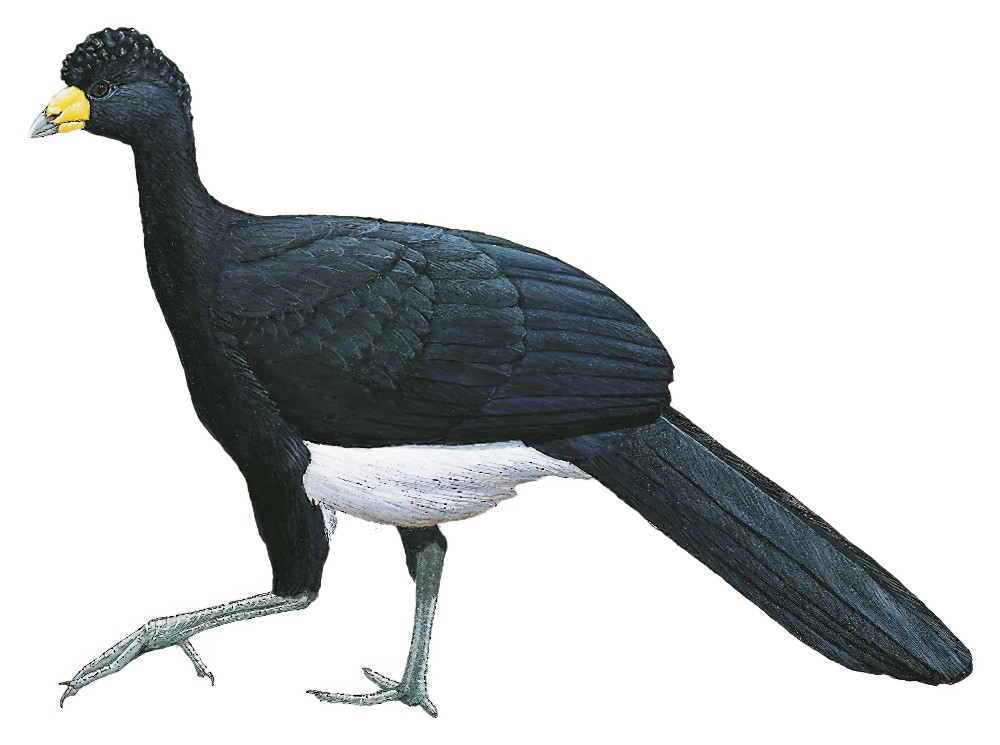Black Curassow / Crax alector

Black Curassow
SCI Name:
Protonym: Crax Alector Syst.Nat.ed.12 ed.12 p.269
Taxonomy: Galliformes / Cracidae / Crax
Taxonomy Code: blacur1
Type Locality: 'America calidiore.''
Author: Linnaeus
Publish Year: 1766
IUCN Status: Vulnerable
DEFINITIONS
CRAX
(Cracidae; Ϯ Great Curassow C. rubra) Gr. κρα kra humorous abbreviation for κρανος kranos helmet (cf. κρας kras head; ουραξ ourax unidentified gamebird, perhaps a grouse). The name was first introduced by Linnaeus 1744, based on "Cocq Indien" of Dodart 1671-1676, and "Gallus Indicus", "Quirizao" or "Curasso" of Sloane 1725: "It was brought from the Island Quirizao, Curassao or Curasso, belonging to the Dutch, to Jamaica." "Gallus indicus Sloan. Hist. nat. Jam. Crax Linn. Syst. nat. Hocco des Amazones* ... *Crax, Avis Græce sic dicta a clarissimo Linnæo, a galea seu corolla pennacea revoluta" (Barrère 1745) (Laurent Raty in litt.); "89. CRAX. Rostrum basi cera obtectum. Pennæ caput tegentes revolutæ." (Linnaeus 1758): based on "Gallus curassavicus" of Aldrovandus 1599-1603, "Mitu" of Marcgrave 1648, Willughby 1676, and Ray 1713, and "Gallus Indicus" of Sloane 1725; "Crax Linné, Syst. Nat., ed. 10, 1, 1758, p. 157. Type, by subsequent designation, Crax rubra Linné. (Ridgway, Man. No. Am. Bds., ed. 2, 1896, p. 207.)1 ... 1 Crax alector Linné, 1766, is usually given as the type of the genus, but was not one of the originally included species, hence is unavailable in this connection." (Peters, 1934, II, p. 10). Linnaeus's Crax comprised two species (C. nigra, C. rubra).
Var. Craxa, Urax.
Synon. Alector, Crossolaryngus, Mituporanga, Sphaerolaryngus.
alector
Gr. αλεκτωρ alektōr, αλεκτορος alektoros cockerel.
● ex “Hocco de la Guiane” of Brisson 1760; "Although Linné's synonymy contains various inapplicable references such as Sloane, Hernandez, and Marcgrave's "Mituporanga," his description, which seems to have been taken largely from Brisson, is unmistakable." (Hellmayr & Conover 1942) (Crax).
Alector
● (Cracidae; syn. Crax Ϯ Black Curassow C. alector) Specific name Crax alector Linnaeus, 1766; "Observavi etiam in diversis Cracibus, hactenus quidem descriptis, a grandi inde Cracis Alectoris cera ad plane deficientem, inque caeteris congenerum avium speciebus a cutis nudae, sub gutture pendulae, genarumque nudarum, papillosarum, et reliquorum capitis ornamentorum, tam carneorum quam pennaceorum praesentia, ad harum usque rerum defectum, tot vix animaduertendos adesse gradus, qui impediant, quo minus generum characteres certi inde possint depromi; multasque adeo volucrum species, multis modis a systematum conditoribus aut separatas aut coniunctas, tam propinqua cognatione inter se esse connexas, ut omnes ad unum idemque genus, Alector (germanice Hocko) nominandum, referendae sint, sitque adeo verisimile, eas, nisi magnitudo impediat, generatione hybrida pullos procreare posse" (Merrem 1786); "Alector5 B. MERREM ... 5 The name Alector becomes a synonym of Crax. It was proposed by Merrem not as a substitute name for Crax, but as a comprehensive genus to include Crax, Penelope, and Ortalis." (Richmond 1927); "Alector Merrem, Av. Rar. Icon. et Descr., fasc. 2, 1786, p. 40. Type, by tautonymy, Crax alector Linné." (Peters, 1934, II, p. 10).
● (Phasianidae; syn. Gallus † Red Junglefowl G. gallus) Gr. αλεκτωρ alektōr, αλεκτορος alektoros cockerel; "Kammhuhn. Alector. 42. Schnabel: kurz, stark, gebogen. Wangen: mit einer federlosen nackten Haut. Stirne: mit einem fleischigen Kamme. ... Kammhuhn. Haushuhn. 102. Eine nackte Stelle an der Ohrgegend; der Schwanz aufgerichtet. Phasianus Gallus. Lin. faun. suec. n. 199." (von Paula Schrank 1798); "Alector von Paula Schrank, 1798, Fauna Boica, I, p. 135. Type, by monotypy, Phasianus gallus Linnaeus, 1758." (JAJ 2021).
SUBSPECIES
Black Curassow (erythrognatha)
SCI Name: Crax alector erythrognatha
erythrognatha / erythrognathus
Gr. ερυθρος eruthros red; γναθος gnathos jaw.
Black Curassow (alector)
SCI Name: Crax alector alector
alector
Gr. αλεκτωρ alektōr, αλεκτορος alektoros cockerel.
● ex “Hocco de la Guiane” of Brisson 1760; "Although Linné's synonymy contains various inapplicable references such as Sloane, Hernandez, and Marcgrave's "Mituporanga," his description, which seems to have been taken largely from Brisson, is unmistakable." (Hellmayr & Conover 1942) (Crax).
UPPERCASE: current genus
Uppercase first letter: generic synonym
● and ● See: generic homonyms
lowercase: species and subspecies
●: early names, variants, mispellings
‡: extinct
†: type species
Gr.: ancient Greek
L.: Latin
<: derived from
syn: synonym of
/: separates historical and modern geographic names
ex: based on
TL: type locality
OD: original diagnosis (genus) or original description (species)












